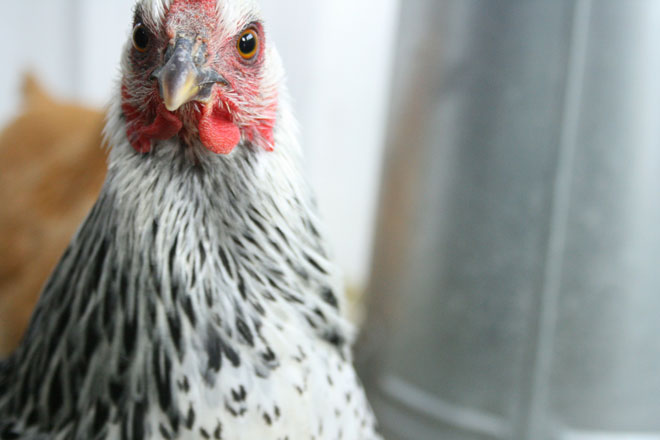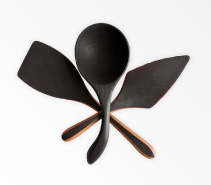While eggs have been called Nature’s miracle food, they simply wouldn’t exist without chickens. Or, wait… would chickens not exist without eggs? Hmm. The age-old riddle. Like the whereabouts of Jimmy Hoffa, we’ll probably never know, but in the spirit of fowl play I did some digging into the homegrown chicken industry and made some interesting discoveries.
Backyard chicken keeping (an extension of the “eat local” urban farming movement to raise livestock or grow your own food to reduce energy costs and carbon emissions) is on the rise, according to Worldwatch Institute, an organization devoted to global sustainability.
In many ways, the chicken has become the mascot of the locavore movement. It’s not the first time the proud poultry has been the standard-bearer for a social shift. In 1928, the Republican National Committee’s advertisement supporting Herbert Hoover’s presidential campaign touted its track record that had “reduced hours and increased earning capacity, silenced discontent and put the proverbial ‘chicken in every pot.’”
But why chickens? BackYard Chickens, one of the go-to online resources for chicken-ry, conducted an informal poll of its subscribers about the various reasons why they have chickens in their back yards.
Perhaps not surprisingly, 92 percent of respondents said it was for the eggs. The second-most popular answer, with 72 percent, was that they were kept for pets (making the 26 percent who said they kept chickens for food seem positively barbaric). All those answers sound, well, really good. Low carbon footprint. Healthy. Sustainable. Fewer bugs. Natural fertilizer. Why doesn’t everyone have a chicken in their backyard?
“The biggest advantage to keeping your own chickens is that you get to control what goes in to the egg,” says Greg Anderson, program manager of Just Foods’ City Farms initiative. Just Food is the New York-based sustainable food organization committed to connecting communities and local farms with the resources they need to make fresh, locally grown food accessible to all New Yorkers. In addition to invertebrate foods like fruits and vegetables delivered via CSA (Community-Supported Agriculture) programs, Just Food is also in the non-profit chicken business.

A volunteer for Just Food NYC with chickens at the Brook Park Coop in the Bronx. Image credit: Lily Kesselman.
Commercially bought chickens are typically loaded down with chicken feed that contains animal byproducts and antibiotics to keep the animals marginally healthy enough to lay large quantities of eggs. With your own chickens, Anderson says, seeing is believing.
“We get to see the chicken, so we know how healthy that chicken is, and we can work to improve the health of the chicken when necessary,” he says. “We don’t have to use antibiotics or steroids or anything because we’re feeding them fresh foods and giving them a complete diet.”
Plus, you know you’re getting fresher eggs than store-bought, which are usually already two to four weeks old by the time they get to store shelves, Anderson says.
Luckily, there are plenty of excellent sources online to help get you started if you’re interested in talking, er, chicken.
The Chicken Whisperer (also known as Andy Schneider) is a nationally known expert on chickens. His “Backyard Poultry with the Chicken Whisperer” program on blogtalkradio is worth a listen if only for the theme song, not to mention the actual content, which covers everything from chicken diseases like bumblefoot to general care and upkeep.

A Silver Laced Wyandotte, a heritage breed chicken. Image credit: Moosicorn Ranch.
For the official word, the American Poultry Association is a good place to start. The APA recognizes more than 460 varieties of chickens (at least the ones that qualify for poultry shows and awards), with exotic names that belie the simple pleasure of a barnyard bird. Names like Barred Rocks (also known as Plymouth Rock, an original American breed) and Araucanas to dark-shelled layers like Barnevelder, Empordanesa, Pendesenca or Welsummers.
There are chickens known as Sex-Links, which are bred so that males and females are different colors from chickhood. This is apparently quite helpful, since no one wants to go home with handful of innocent-looking yellow chicks and in a few weeks realize that they’ll have attitude instead of eggs.
Most chicken-lovers agree that the majority of home farmers rely on a mixed-breed mutt known as an Easter Egger. Also known as Rainbow Layers, these chickens have a blue-egg gene that means the colors of their shells span the color spectrum from blues and greens to pinks and blush.

At left, a Rhode Island Red hen (Image credit: Garrett Heath), at right a black sex link rooster (image credit: Jessica Denet).
For the first-time chicken-keeper, the most important thing to consider is why you want to keep chickens. That should spur what kind of bird you get, as the multitudes of breeds all serve different purposes. Heritage breeds, whose lineage date back prior to the mid 20th century and are subject to strict APA guidelines, are truly gorgeous, but they aren’t necessarily bred for egg production. You may get one egg a day from a Rhode Island Red or a Leghorn (the most popular commercially used breed), but just one every other day from an “antique” bird.
The Chicken Chick gives great tips about care and specific issues like “Drop in Egg Production: Causes & Solutions” and “5 Tips to Prepare for Chicken Illness, Injury & End of Life Decisions.”

Eggs from heritage breed chickens in a multitude of colors. Image credit: Steven L. Johnson.
At some point, every chicken will stop laying eggs and become a pet… or dinner. While regulations vary depending on the area, in New York City, a backyard chicken must be slaughtered on premises. Yes, that’s right. Either the owner or someone else brought on to the property must do the deed because city policy doesn’t allow for transport of a kept bird to a slaughterhouse.
Gulp.
For Just Foods’ Greg Anderson, it’s part of the circle of life.
“We understand that the animal is something to give us life, so we have to respect that and treat the animal as well as we can during its entire lifetime,” he says, which includes a humane death.
If you’re really interested in chickens, one of the easiest ways to get started is via BackYard Chicken’s primer on going from the chicken to the egg. Or, visit one of Just Foods’ monthly chicken workshops.
“Keeping your own chickens, you know your chickens are not only healthy physically, but they’re also emotionally healthy,” Anderson says. “It’s the interacting with our food that’s the biggest plus.”
Use these products from Hudson Made when preparing your next delicious egg-based meal:
 |
 |
 |
| Flour Sifter | Flap Jack | The Trio |
Laura Grimmer is a professional cook and sommelier who lives to eat, drink and provide sustenance. She came late to the culinary world, selling her PR firm and enrolling at the French Culinary Institute because of a borderline fixation on master chef Jacques Pépin. She left cooking school a classically trained chef with a deeply seated appreciation for tradition in the kitchen. www.perfectpairnyc.com

